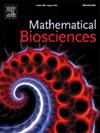模拟肿瘤微环境中巨噬细胞-肿瘤相互作用引起的双稳态动力学。
IF 1.8
4区 数学
Q2 BIOLOGY
引用次数: 0
摘要
肿瘤微环境(TME)中的巨噬细胞,称为肿瘤相关巨噬细胞(tam),主要来自循环单核细胞,在肿瘤来源信号的影响下分化。在TME内,naïve巨噬细胞可以采用促炎、抗肿瘤(m1样)或抗炎、促肿瘤(m2样)表型。这些表型变化显著影响肿瘤进展,使tam成为旨在阻断招募、促进抗肿瘤极化或破坏肿瘤-巨噬细胞相互作用的治疗干预的有吸引力的靶点。在这项研究中,我们建立了一个数学模型,捕捉肿瘤体积的时间动态以及naïve, M1样,M2样和混合(M1/M2)表型tam的种群。该模型纳入了肿瘤发展与巨噬细胞极化之间的双向影响。通过不同参数集的数值模拟,我们的肿瘤-巨噬细胞群体模型显示出双稳定性的出现,表明系统变得更加可控,对扰动反应灵敏,对免疫治疗敏感。我们进行了分岔分析和全局敏感性分析,以确定参数空间中肿瘤动力学的双稳定区域以及敏感参数对TME的影响。这些结果与可能有效诱导从高肿瘤负荷到低肿瘤负荷转变的治疗策略相关联。本文章由计算机程序翻译,如有差异,请以英文原文为准。
Modeling bistable dynamics arising from macrophage–tumor interactions in the tumor microenvironment
Macrophages in the tumor microenvironment (TME), known as tumor-associated macrophages (TAMs), originate primarily from circulating monocytes that differentiate under the influence of tumor-derived signals. Within the TME, naïve macrophages can adopt either a pro-inflammatory, anti-tumor (M1-like) or anti-inflammatory, pro-tumor (M2-like) phenotype. These phenotypic shifts significantly affect tumor progression, making TAMs attractive targets for therapeutic intervention aimed at blocking recruitment, promoting anti-tumor polarization, or disrupting tumor–macrophage interactions. In this study, we develop a mathematical model capturing the temporal dynamics of tumor volume alongside populations of naïve, M1-like, M2-like, and mixed (M1/M2) phenotype TAMs. The model incorporates the bidirectional influence between tumor development and macrophage polarization. Through numerical simulations with different parameter sets, our tumor–macrophage population model exhibits the emergence of bistability, demonstrating the system becomes more controllable, responsive to perturbations, and sensitive to immunotherapy. We conduct the bifurcation as well as global sensitivity analyses to identify regions of bistability for tumor dynamics in the parameter space and the impact of sensitive parameters on TME. These results are then linked to treatment strategies that may effectively induce transitions from high to low tumor burden.
求助全文
通过发布文献求助,成功后即可免费获取论文全文。
去求助
来源期刊

Mathematical Biosciences
生物-生物学
CiteScore
7.50
自引率
2.30%
发文量
67
审稿时长
18 days
期刊介绍:
Mathematical Biosciences publishes work providing new concepts or new understanding of biological systems using mathematical models, or methodological articles likely to find application to multiple biological systems. Papers are expected to present a major research finding of broad significance for the biological sciences, or mathematical biology. Mathematical Biosciences welcomes original research articles, letters, reviews and perspectives.
 求助内容:
求助内容: 应助结果提醒方式:
应助结果提醒方式:


